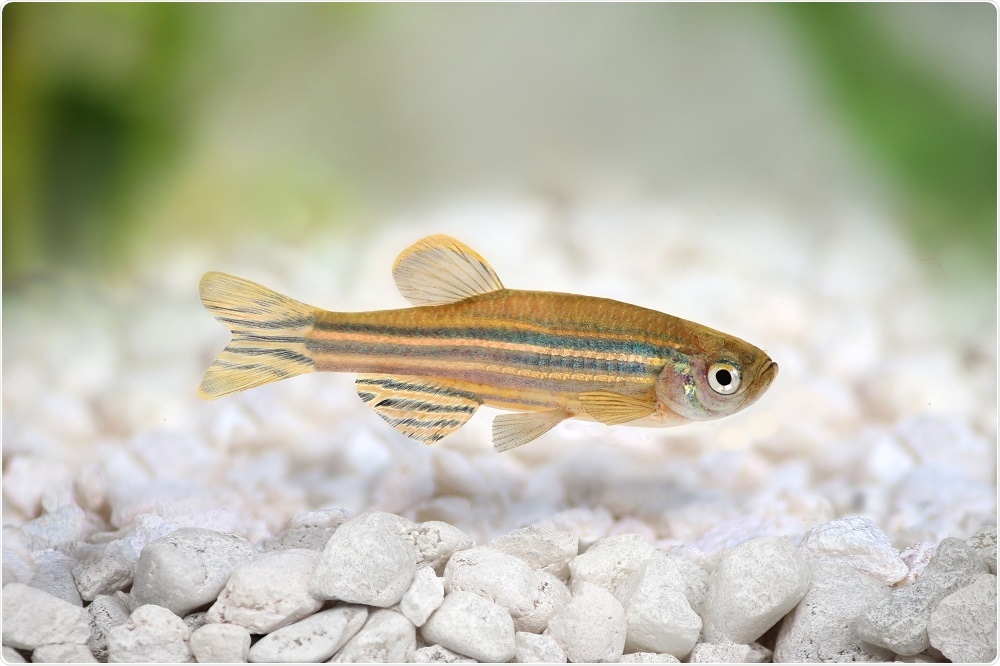One of the most popular animal models in research is the Zebrafish, a tropical fish which is native to the rice paddies of Asia.
 Credit: Mirko Rosenau/Shutterstock.com
Credit: Mirko Rosenau/Shutterstock.com
Complex ethical concerns surrounding human testing have resulted in the use of animal models within the field of medical research. There are many different animal models, ranging from flies to monkeys to mice, which are used to investigate human disease.
Zebrafish are known by their latin name, “Danio rerio”. However, their striped bodies resemble that of a Zebra, thus giving them their commonly used name, Zebrafish. The stripes are navy and horizontal, running along the length of the body from the caudal fin to their gills.
Zebrafish have been kept as pets for a long time, however, they were first used in medical research by George Streisinger in the 1960s. After years of work, Streisinger successfully managed to clone a Zebrafish, creating the first ever successful vertebrate clone.
After this landmark achievement, the popularity of this model has increased dramatically and is now used in research for a vast range of human diseases.
Why do zebrafish make such good animal models?
Zebrafish are widely used in research due to their numerous beneficial properties.
Maintenance
Firstly, Zebrafish are very robust and easy to maintain. Since they are naturally found in ponds, their ideal conditions can be easily replicated.
They are also very cheap; however, they do require more space than other model organisms such as flies. This model is also a vertebrate, which gives it an advantage over other models.
Reproduction
Zebrafish have extraordinarily high fecundity, producing multiple hundreds of eggs each week. They also have a very short generation time, meaning that scientists have a never-ending supply of this model. This shortens the overall experimental process and is particularly useful in mutant production.
Another advantage is that Zebrafish eggs develop externally, allowing scientists to study their initial development easily. This is an advantage over other models, such as mice, which develop internally and therefore hinder visual investigation.
Morphological features
The transparency of Zebrafish helps in observing their internal structures in situ. Their organs share the same main features as humans and so can be used to study human developmental processes.
The Zebrafish embryos can also be genetically modified. Zebrafish share 70% of their genes with humans, and 84% of disease-related genes have a zebrafish counterpart. . Zebrafish genome has been fully sequenced and over 140,000 genes have been mutated to study their function in development and disease.
Applications of Zebrafish in research
Hematopoeisis
Zebrafish play a major role in the study of hematopoiesis. These fishes have the same sequential multilineage hematopoiesis process as humans, with the same distinct lineages. This model has therefore provided scientists with many insights, both in blood lineage development pathways and blood disorders.
Cardiovascular disease
These fishes are also largely used for investigating cardiovascular diseases as they have a similar embryonic heart structure as that of human embryos. Furthermore, Zebrafish have the advantage of being able to survive without adequate cardiac circulation.
Oxygen enters the embryo of the Zebrafish and reaches other tissues by passive diffusion. This unique feature helps the embryo develop from the initial phases despite cardiovascular defects. One example of their use within this field is exploring the link between inflammation and myocardial infarction.
Neurology
This model is also extensively used to study neurological diseases due to the abundance of similar signaling proteins in the brains of both humans and Zebrafish. Several human neurological disorders also have counterparts in these fishes.
For example, the one-eyed pinhead is a Zebrafish mutant which contains a smaller ventral brain and has one eye only. This has been compared to the human disorder ‘holoprosencephaly’, in which patients have a small brain and one eye. This comparison has enabled the identification of several genes associated with this condition, such as CFC1.
Genetics
Zebrafish represent a vital tool in the investigation into novel therapeutics for disease, as discovery of disease related-genes enables identification of gene-specific drug targets.
By mutating a specific gene in the Zebrafish embryo, the mutant can be analyzed during development and used to identify disease related-genes. The resultant observation can then be extrapolated to the human genome to see if the same mutant gene is what causes a particular human genetic disorder.
Overall, Zebrafish are particularly useful as animal models due to their low cost, short breeding time, and relative similarity to humans.
Laboratory of Development and Disease Models in Zebrafish
Further Reading
Last Updated: Jul 19, 2023